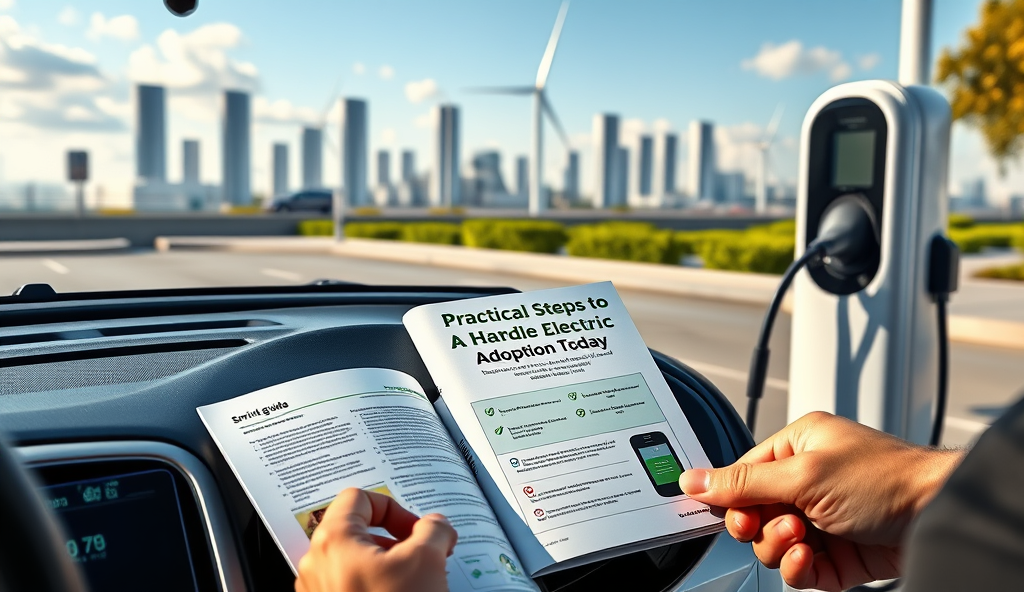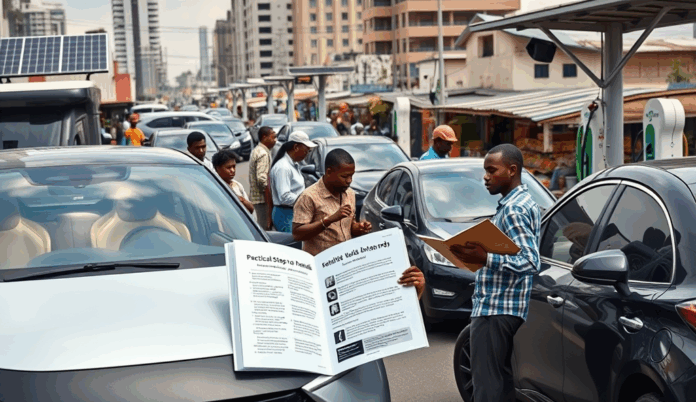Introduction to Electric Vehicle Adoption in Nigeria
Nigeria’s transition to electric vehicles presents both opportunities and challenges, particularly given the country’s reliance on fossil fuels and growing urban mobility demands. With transport contributing 23% of Nigeria’s CO2 emissions, EV adoption could significantly reduce environmental impact while aligning with global sustainability goals.
Key barriers include limited EV charging infrastructure in Nigeria and high upfront costs, though initiatives like Lagos State’s proposed EV policy aim to address these gaps. The Nigerian market shows potential, with rising fuel prices and increasing renewable energy capacity creating favorable conditions for EV integration.
Understanding these dynamics is crucial for policymakers crafting effective incentives for electric vehicle buyers in Nigeria. The next section will explore the current state of EV adoption, examining progress and persistent challenges in greater detail.
Key Statistics

Current State of Electric Vehicle Adoption in Nigeria
Nigeria's transition to electric vehicles presents both opportunities and challenges particularly given the country's reliance on fossil fuels and growing urban mobility demands.
Nigeria’s EV adoption remains nascent, with fewer than 1,000 registered electric vehicles as of 2023, representing less than 0.1% of total vehicles on Nigerian roads. However, pilot projects like the Lagos State electric buses and private sector initiatives by companies like Jet Motors demonstrate growing interest despite infrastructure gaps.
The Nigerian market shows increasing readiness for electric vehicles, with over 60% of urban commuters expressing willingness to switch if charging stations become widely available. Rising fuel prices, now averaging ₦600 per liter in major cities, are accelerating consumer interest in EV alternatives as cost-saving measures.
While EV adoption faces barriers like limited charging infrastructure in Nigeria, recent partnerships between energy firms and automakers signal progress. These developments set the stage for discussing government policies needed to scale adoption, which we’ll explore next.
Government Policies Supporting Electric Vehicle Adoption
Nigeria's EV adoption remains nascent with fewer than 1000 registered electric vehicles as of 2023 representing less than 0.1% of total vehicles on Nigerian roads.
Building on Nigeria’s emerging EV landscape, the federal government has introduced the National Automotive Industry Development Plan (NAIDP), which includes provisions for local EV manufacturing and import duty reductions for electric vehicles. Lagos State has taken the lead with its 2020 Electric Vehicle Policy, targeting 30% EV penetration in public transport by 2030 through infrastructure investments and pilot programs like its electric bus fleet.
Recent policy developments include the Nigerian Electricity Regulatory Commission’s 2022 guidelines for EV charging stations, addressing one of the key barriers mentioned earlier by standardizing infrastructure deployment. The Central Bank of Nigeria also introduced a ₦300 billion intervention fund for clean energy projects, with 15% allocated specifically to EV-related initiatives, creating financial support mechanisms for manufacturers and consumers alike.
These policy frameworks lay crucial groundwork for scaling EV adoption, but their effectiveness hinges on implementation and complementary incentives. As we’ll explore next, targeted incentives for both buyers and manufacturers could accelerate Nigeria’s transition to electric mobility while addressing cost concerns raised in previous sections.
Incentives for Electric Vehicle Buyers and Manufacturers
Lagos State has taken the lead with its 2020 Electric Vehicle Policy targeting 30% EV penetration in public transport by 2030 through infrastructure investments and pilot programs like its electric bus fleet.
Building on the policy foundations discussed earlier, Nigeria offers import duty reductions of up to 30% for electric vehicles under the NAIDP, significantly lowering acquisition costs for buyers. Manufacturers benefit from pioneer status incentives, including tax holidays for local EV production, complementing the Central Bank’s ₦45 billion EV-focused allocation from its clean energy fund.
Lagos State provides additional perks like waived registration fees for electric vehicles and priority lane access for EV public transport operators. These measures directly address the cost concerns raised in previous sections while stimulating market demand and local manufacturing capacity.
However, as these incentives gain traction, their impact will depend on overcoming persistent challenges in Nigeria’s EV ecosystem, which we’ll examine next.
Challenges Facing Electric Vehicle Adoption in Nigeria
Nigeria’s EV sector presents untapped potential with renewable energy integration offering solutions to grid reliability concerns—solar-powered charging stations could leverage the country’s 2600 average annual sunlight hours.
Despite the incentives outlined earlier, Nigeria’s EV adoption faces infrastructural hurdles, with only 23 public charging stations nationwide as of 2023, concentrated in Lagos and Abuja. Limited grid reliability compounds this challenge, with 43% of potential EV users citing power outages as a deterrent according to a recent NBS survey.
High upfront costs persist despite duty reductions, with entry-level EVs priced around ₦25 million—three times the average annual income of Nigerian households. Battery replacement expenses averaging ₦5 million every 5-7 years further deter mass adoption in price-sensitive markets.
Technical skill gaps in EV maintenance and inadequate local component manufacturing capacity threaten sustainability, despite the pioneer status incentives. These systemic barriers must be addressed to fully realize the potential of Nigeria’s EV policies, creating opportunities for growth which we’ll explore next.
Opportunities for Growth in the Electric Vehicle Sector
Nigeria’s EV adoption could reach 10% of new vehicle sales by 2030 if current pilot projects like Lagos’ solar-powered hubs scale nationally though this depends on resolving grid instability.
Nigeria’s EV sector presents untapped potential, with renewable energy integration offering solutions to grid reliability concerns—solar-powered charging stations could leverage the country’s 2,600 average annual sunlight hours. Local assembly initiatives, like Stallion Group’s planned EV manufacturing plant in Lagos, align with pioneer status incentives to reduce import dependence and create jobs.
Public-private partnerships could accelerate infrastructure development, as seen in Kenya’s successful deployment of 30 solar charging stations through government-backed investor collaborations. Scaling EV adoption also opens opportunities for vocational training programs to address technical skill gaps, with institutions like the National Automotive Design and Development Council already piloting EV maintenance courses.
The growing middle class and ride-hailing services provide a ready market for affordable EV models, with startups like MAX.NG testing electric tricycles for last-mile transport. These developments set the stage for discussing the critical role of infrastructure in Nigeria’s EV transition, which we’ll examine next.
Role of Infrastructure in Electric Vehicle Adoption
Nigeria’s EV transition hinges on robust charging infrastructure, with solar-powered stations offering a viable solution given the country’s 2,600 annual sunlight hours—Lagos already hosts pilot projects like Eko Electric’s solar-powered hubs. Public-private partnerships, modeled after Kenya’s success, could fast-track deployment, particularly along major corridors like Abuja-Lagos, where grid reliability remains a challenge.
Beyond charging networks, Nigeria must upgrade power distribution systems to handle increased EV load, leveraging renewable microgrids to offset grid instability, as demonstrated by the World Bank-funded Energizing Education Initiative. Training programs, like those by the National Automotive Design and Development Council, will be critical to maintaining this infrastructure, creating jobs while addressing technical skill gaps.
The success of startups like MAX.NG highlights the need for last-mile infrastructure, including battery-swapping stations for electric tricycles in urban centers. These localized solutions, combined with national grid improvements, will determine Nigeria’s competitiveness in Africa’s EV landscape—a theme explored next in comparative regional analysis.
Comparative Analysis with Other African Countries
Nigeria’s EV infrastructure development lags behind South Africa, which boasts over 200 public charging stations and incentives like reduced import duties, but leads West Africa in pilot projects like Lagos’ solar-powered hubs. Kenya’s successful public-private partnerships for charging networks, mentioned earlier, offer a replicable model for Nigeria’s Abuja-Lagos corridor, though Nigeria must address grid instability more aggressively than Kenya’s 90% electricity access rate.
Egypt and Morocco lead in EV manufacturing with local assembly plants, while Nigeria’s MAX.NG demonstrates potential for localized solutions like battery-swapping—critical for urban mobility where grid reliability mirrors challenges seen in Ghana’s Accra. Rwanda’s nationwide EV policy, including tax exemptions, highlights regulatory gaps Nigeria must close to compete regionally, particularly in harmonizing standards across ECOWAS markets.
These regional disparities underscore Nigeria’s need for integrated strategies combining renewable microgrids (as piloted by the Energizing Education Initiative) with workforce development to match South Africa’s technical capacity—a foundation for future EV adoption projections.
Future Projections for Electric Vehicle Adoption in Nigeria
Nigeria’s EV adoption could reach 10% of new vehicle sales by 2030 if current pilot projects like Lagos’ solar-powered hubs scale nationally, though this depends on resolving grid instability and replicating Kenya’s public-private charging partnerships along key corridors. The Abuja-Lagos route alone could support 50 fast-charging stations by 2027, mirroring South Africa’s infrastructure but adapted to Nigeria’s renewable microgrid solutions.
Localized manufacturing following Egypt’s model could reduce EV costs by 30% by 2035, particularly if Nigeria leverages existing startups like MAX.NG for battery-swapping systems tailored to urban mobility needs. Rwanda’s tax exemption framework suggests Nigeria’s EV market could grow 15% annually with similar policies, especially if harmonized across ECOWAS to attract regional investment.
The Energizing Education Initiative’s renewable microgrids provide a blueprint for integrating EV charging with solar energy, potentially powering 20% of public stations by 2030 while addressing grid limitations. Workforce development programs must parallel this growth to meet South Africa’s technical standards, ensuring local capacity sustains the projected adoption curve.
Conclusion and Recommendations for Policymakers
Given Nigeria’s growing energy demands and urban pollution challenges, accelerating electric vehicle adoption requires targeted policy interventions. Building on existing initiatives like the National Automotive Industry Development Plan, policymakers should prioritize expanding EV charging infrastructure in Nigeria, particularly in Lagos and Abuja, where traffic congestion is highest.
To overcome barriers to electric vehicle adoption in Nigeria, incentives such as tax rebates for local manufacturers and reduced import duties on EV components could stimulate market growth. Pairing these measures with public awareness campaigns would address misconceptions about EV costs and reliability, fostering wider acceptance.
Finally, integrating renewable energy sources like solar power with EV charging networks would align with Nigeria’s climate goals while ensuring sustainable energy use. Policymakers must collaborate with private sector stakeholders to create a cohesive roadmap for Nigeria’s EV transition.
Frequently Asked Questions
How can Nigeria balance EV adoption with its current unreliable power grid?
Prioritize solar-powered charging stations and microgrid solutions like those in the Energizing Education Initiative to bypass grid limitations.
What immediate incentives would most effectively boost EV purchases among Nigerian consumers?
Implement direct purchase subsidies and VAT exemptions for EVs while expanding Lagos-style perks like waived registration fees nationwide.
How can Nigeria develop local EV manufacturing without relying heavily on imports?
Leverage pioneer status incentives to attract assembly plants while funding vocational training programs for EV component production through NADDC partnerships.
What infrastructure strategy would best serve Nigeria's diverse urban-rural EV needs?
Deploy solar charging hubs in cities while piloting mobile battery-swapping stations for rural areas using MAX.NG's tricycle model as a template.
How can Nigeria's EV policies align with broader West African regional markets?
Harmonize standards with ECOWAS neighbors and create cross-border charging corridors modeled after Kenya's successful public-private partnerships.


